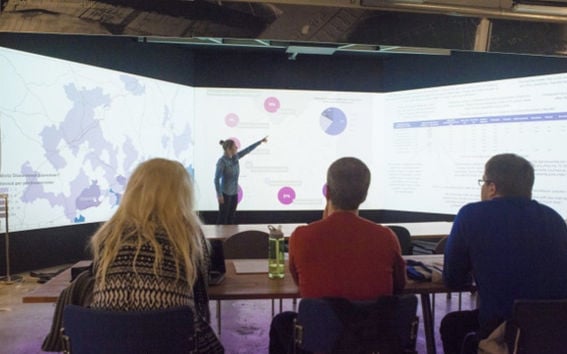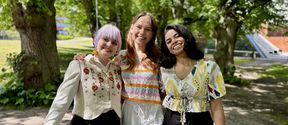SASUI course closing was held in ABE Space

The Land Use Strategies and Planning Cooperation course, arranged this year as a part of the SASUI (Systemic Architectures for Sustainable Urban Development) research project, culminated in student presentations on 3rd December in Aalto Built Environment Laboratory (ABE) Space in Urban Mill. The topic of the presented project works was the Otaniemi area in Espoo. Commenting on the work in the audience were also the representatives of Espoo city planning office. The course is organized by YTK Land Use Planning and Urban Studies Group.
During the course, one of the students’ tasks was to prepare normative and explorative scenarios depicting the future of the Otaniemi area. In strategic planning, a normative scenario describes a future with desirable outcomes, and an explorative scenario a future with undesirable outcomes. Both scenarios should present credible trajectories. For example, an explorative scenario depicts a trajectory that is likely to unfold if identified threats are not adequately responded to.
Among other things, the students’ normative scenarios featured the idea of mixed and flexible usage of spaces and a “24/7 life” in Otaniemi. In contrast, in the explorative scenarios, sticking to one purpose per space led into an area without activities in the evenings and nights. The threat of global warming inducing weather uncertainties and rises in the sea level in the coastal Otaniemi was also a part of one explorative scenario. The students utilized the three screen system of ABE Space to show the visualizations of the scenarios.
In a discussion following the presentations, Espoo city representatives asked questions and the students reflected on what they had learned during the course. One student pointed out that from strategic perspective it feels hard and even unfruitful to consider one area in isolation as it is strongly affected by global and local trends. Despite the challenges, the point of view of looking things from a strategic long term perspective was deemed important.
A closing statement by the organizing teacher Raine Mäntysalo was that creating such scenarios together with different stakeholders would be beneficial for any planning process. This would perhaps motivate the stakeholders to work on reaching the normative scenarios together. This in turn, would shift the regulative perspective of city planning into a perspective of common mobilization.
Aligning interests through a dialogue between the stakeholders of an area and co-design in city planning are exactly something Aalto Built Environment Laboratory aims to facilitate and study.
More information on the course and the SASUI project: Kaisa Schmidt-Thomé.
Read more news

Online AI course could boost study equality
Students at the School of Business believe that mastering Artificial Intelligence (AI) can be beneficial for both academic success and career prospects, as AI becomes increasingly integrated into daily life.
2 027 new students admitted to Aalto University’s Finnish, Swedish bachelor’s programmes
13 500 applied to Aalto University in Finland's spring joint application in 2024
Meet the the Program Assistants that elevate the Aalto University Summer School experience for 250 students from all over the world
Each year, the Aalto University Summer School has grown its operations and course curriculum tremendously.